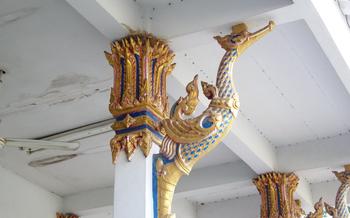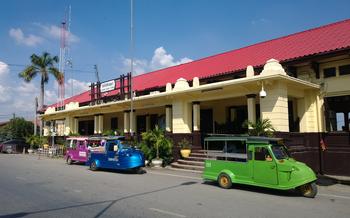
Ranong City Pillar Shrine
- Ranong City Pillar Shrine: An Ode to Cultural Heritage
- Unveiling the Shrine's History: A Journey Through Time
- Exploring the Shrine's Architecture: A Fusion of Styles
- Unveiling the Sacred Rituals: A Glimpse into Local Beliefs
- Witnessing Festivals and Ceremonies: A Cultural Extravaganza
- Photography Tips: Capturing the Shrine's Essence
- Unveiling the Legends and Myths: A Realm of Folklore
- Interactive Displays and Exhibitions: A Deeper Dive into History
- Serenity Amidst the Bustle: Finding Inner Peace
- Respecting Local Customs and Traditions: A Guide for Visitors
- Engaging with the Community: Building Cultural Bridges
- Exploring Surrounding Attractions: A Journey into Ranong's Treasures
- Insider Tip: Unveiling Hidden Gems
Ranong City Pillar Shrine: An Ode to Cultural Heritage
The Ranong City Pillar Shrine stands as a testament to the rich cultural heritage of Ranong, Thailand. Erected in 1870, this sacred site holds immense historical significance, serving as a symbol of the city's founding and a guardian of its people. The shrine's architectural features showcase a harmonious blend of Thai and Chinese influences, reflecting the diverse cultural tapestry of Ranong. Visitors are drawn to the intricate carvings, colorful decorations, and symbolic motifs that adorn the shrine, each element narrating a chapter in the city's history.
The Ranong City Pillar Shrine is not merely a historical landmark; it is a living embodiment of the city's spiritual beliefs and practices. Locals flock to the shrine daily to offer prayers, light incense, and seek blessings from the resident deities. The shrine also plays a pivotal role in Ranong's vibrant festivals and ceremonies, transforming into a stage for colorful processions, traditional performances, and communal celebrations.
Unveiling the Shrine's History: A Journey Through Time
The Ranong City Pillar Shrine, steeped in history and cultural significance, has a captivating narrative that unfolds through the passage of time. Its origins can be traced back to the founding of Ranong as a city. According to local legends, the shrine was established as a sacred site to honor the city's founding spirits and deities. These spirits were believed to protect and guide the city, ensuring its prosperity and well-being.
The shrine's architectural style reflects the cultural influences that have shaped Ranong over the centuries. Thai and Chinese elements blend harmoniously, showcasing the city's rich heritage as a crossroads of diverse cultures. The shrine has undergone several renovations and transformations throughout history, each leaving its mark on the structure. These changes reflect the evolving beliefs and practices of the local community and the shrine's enduring role as a symbol of cultural continuity.
Preservation efforts have been undertaken to maintain the shrine's historical integrity and ensure its legacy for future generations. Local authorities and cultural organizations have collaborated to restore and conserve the shrine's original features, ensuring that its architectural beauty and historical significance are preserved.
Exploring the Shrine's Architecture: A Fusion of Styles
The Ranong City Pillar Shrine stands as a testament to the harmonious blend of Thai and Chinese architectural influences. Its unique design captivates visitors with intricate carvings, vibrant colors, and symbolic motifs that tell stories of the past.
Architectural Elements: - The shrine's exterior boasts intricate carvings depicting mythical creatures, floral patterns, and scenes from Thai mythology. These carvings showcase the exceptional craftsmanship of local artisans and add a touch of grandeur to the structure.
-
The shrine's interior features an ornate altar adorned with colorful tiles, gold leaf, and intricate lacquer work. The altar is the focal point of the shrine, where offerings are made and prayers are whispered.
-
The shrine's roof is a masterpiece in itself, with multiple tiers and elaborate gable ends. The roof is adorned with colorful ceramic tiles, bells, and spires that create a striking visual effect.
Symbolic Motifs: - The shrine's architecture is rich in symbolic motifs that hold deep cultural significance. For example, the naga, a mythical serpent, is a common motif representing protection and prosperity.
- The lotus flower symbolizes purity and enlightenment, while the elephant represents strength and dignity. These motifs are carefully placed throughout the shrine, adding layers of meaning to its design.
Architectural Highlights: - Highlights of the shrine's architecture include its majestic entrance gate, which frames the stunning view of the shrine's interior.
-
The shrine's bell tower, with its intricate carvings and multiple tiers, is another must-see feature.
-
The interior of the shrine is adorned with beautiful murals depicting scenes from Thai mythology, offering visitors a glimpse into the country's rich cultural heritage.
Unveiling the Sacred Rituals: A Glimpse into Local Beliefs
The Ranong City Pillar Shrine is not just a historical and architectural marvel; it's also a place where sacred rituals and ceremonies unfold, offering a glimpse into the deeply rooted beliefs of the local community. Daily offerings and prayers are a common sight, as devotees visit the shrine to pay their respects and seek blessings. The shrine's serene atmosphere is punctuated by the gentle clinking of bells and the rhythmic chanting of prayers.
Special ceremonies and festivals are held throughout the year, attracting both locals and visitors. These events showcase the rich cultural heritage of Ranong and provide an opportunity for the community to come together and celebrate their shared traditions. During these festivals, the shrine comes alive with colorful processions, vibrant performances, and a palpable sense of community spirit.
The shrine plays a significant role in the lives of the local people. It serves as a place of spiritual guidance, where people can come to seek solace, guidance, and support. The shrine's caretakers, known as "Chao Pho," are highly respected figures in the community and are often consulted for advice and blessings. They play a crucial role in preserving and passing on the shrine's traditions and rituals to future generations.
For visitors, it's essential to be respectful of the local customs and etiquette when visiting the shrine. Proper attire and behavior are expected, and visitors should refrain from touching or disturbing any religious objects or offerings. Seeking blessings and guidance from the shrine is encouraged, but it's important to do so in a mindful and respectful manner.
Whether you're a history buff, a spiritual seeker, or simply curious about local traditions, visiting the Ranong City Pillar Shrine is an immersive experience that offers a unique glimpse into the heart and soul of Ranong.
Witnessing Festivals and Ceremonies: A Cultural Extravaganza
The Ranong City Pillar Shrine is not only a place of worship but also a vibrant hub for cultural celebrations and festivals. Throughout the year, the shrine comes alive with colorful processions, traditional performances, and a palpable sense of community spirit.
The most significant festival held at the shrine is the Ranong City Pillar Festival, which takes place annually in April. This grand event pays homage to the city's founding and showcases the rich cultural heritage of Ranong. During the festival, the shrine becomes the center of attention, adorned with vibrant decorations and throngs of devotees.
The festival features a series of elaborate ceremonies, including a procession of sacred Buddha images carried through the city streets. Local performers showcase traditional dances, music, and martial arts, creating a captivating spectacle that draws visitors from near and far.
Participating in these festivals is an immersive experience that allows visitors to witness the depth of local beliefs and traditions. It's a chance to connect with the community, embrace the vibrant Thai culture, and create lasting memories.
Tips for Planning Your Visit During Festivals:
- Check the festival dates in advance to plan your trip accordingly.
- Book your accommodation early, as Ranong experiences an influx of visitors during festival time.
- Arrive early to secure a good spot for watching the processions and performances.
- Dress respectfully, covering your shoulders and knees, as it's a religious event.
- Be prepared for crowds and embrace the lively atmosphere.
- Take your time to explore the shrine's surroundings and soak up the festive ambiance.
Photography Tips: Capturing the Shrine's Essence
The Ranong City Pillar Shrine offers a plethora of photogenic opportunities, allowing you to capture its architectural grandeur, intricate details, and vibrant atmosphere. To make the most of your photography experience, here are some tips to help you capture stunning shots:
-
Best Angles: Position yourself at different angles to capture the shrine's full splendor. Stand directly in front to capture its majestic facade, move to the sides to showcase its intricate carvings, or venture to the back to appreciate its serene ambiance.
-
Lighting Conditions: Choose the right time of day to visit the shrine for optimal lighting. Early morning or late afternoon light provides a warm glow that enhances the shrine's colors and textures. Harsh midday sun, on the other hand, can create unflattering shadows.
-
Avoiding Crowds: To avoid capturing unwanted crowds in your photos, visit the shrine during quieter times, such as early in the morning or late in the afternoon. If visiting during peak hours, be patient and wait for moments when the shrine is less crowded.
-
Editing Techniques: Once you've captured your shots, don't hesitate to enhance them with editing software. Adjust the brightness, contrast, and saturation to make the colors pop. You can also crop the image to remove distractions and focus on the shrine's key features.
Unveiling the Legends and Myths: A Realm of Folklore
The Ranong City Pillar Shrine is steeped in a rich tapestry of legends and myths that have been passed down through generations, adding to its mystique and allure. According to local folklore, the shrine was built on the site where a mythical creature known as a "Naga" was believed to have emerged from the sea and blessed the land. This auspicious event is said to have brought prosperity and good fortune to the region, making the shrine a sacred place for locals.
Another legend associated with the shrine tells the tale of a brave warrior named "Chao Phraya Damrongratchaphanit," who led the people of Ranong to victory in a fierce battle against invading forces. In gratitude for their triumph, the people built the shrine to honor his bravery and commemorate their victory. The shrine has since become a symbol of resilience and unity for the people of Ranong.
These legends and myths are deeply intertwined with the history and culture of Ranong, adding another layer of significance to the Ranong City Pillar Shrine. They remind us of the rich storytelling traditions of Thailand and the importance of preserving cultural heritage for future generations.
Interactive Displays and Exhibitions: A Deeper Dive into History
The Ranong City Pillar Shrine houses a treasure trove of historical artifacts, interactive displays, and informative exhibitions that provide visitors with a deeper understanding of the shrine's significance and the cultural heritage of Ranong. Through these engaging exhibits, visitors can delve into the shrine's rich past, discover its intriguing stories, and gain insights into the beliefs and traditions that have shaped this sacred space.
The shrine's interactive displays employ modern technology to bring history to life. Visitors can explore virtual tours, watch historical documentaries, and engage with touchscreens that provide detailed information about the shrine's architecture, religious practices, and cultural influences. These interactive elements enhance the visitor experience, making learning about the shrine's heritage both enjoyable and accessible.
Among the highlights of the exhibitions are rare artifacts and relics from the shrine's early days. These include ancient statues, ceremonial objects, and documents that offer a glimpse into the shrine's origins and evolution. Visitors can also admire intricate replicas of the shrine's architectural features, allowing them to appreciate the craftsmanship and symbolism behind each detail.
For those seeking a more in-depth understanding, guided tours are available. Led by knowledgeable local guides, these tours provide a comprehensive overview of the shrine's history, religious practices, and cultural significance. Visitors can ask questions, gain insights into the local customs, and receive personalized recommendations for further exploration.
Whether you prefer self-guided exploration or the guidance of a knowledgeable expert, the Ranong City Pillar Shrine's interactive displays and exhibitions offer a captivating journey into the past, enriching your visit and deepening your appreciation for this sacred site.
Serenity Amidst the Bustle: Finding Inner Peace
Amidst the lively streets and bustling markets of Ranong, the City Pillar Shrine stands as an oasis of tranquility, inviting visitors to seek solace and find inner peace. Within the shrine's sacred walls, the air is permeated with a sense of serenity, providing a sanctuary for reflection and spiritual connection.
Designated spaces within the shrine are dedicated to meditation and quiet contemplation. Visitors can retreat to these serene corners, free from the distractions of the outside world, and immerse themselves in a journey of self-discovery. Whether seeking guidance, solace, or simply a moment of respite, the shrine offers a sanctuary for those seeking to connect with their spiritual side.
The shrine's tranquil ambiance encourages visitors to slow down, breathe deeply, and let go of the stresses and worries of daily life. In this sacred space, they can find a sense of peace and harmony, allowing their minds to wander and their spirits to soar.
For those seeking inspiration, the shrine's serene atmosphere provides the perfect backdrop for creative thought and reflection. The intricate carvings, vibrant murals, and symbolic motifs that adorn the shrine's walls and ceilings serve as a source of inspiration, inviting visitors to contemplate the deeper meanings and stories behind these artistic expressions.
Whether seeking solace, inspiration, or simply a moment of tranquility, the Ranong City Pillar Shrine offers a sanctuary for all who seek inner peace and spiritual connection.
Respecting Local Customs and Traditions: A Guide for Visitors
When visiting the Ranong City Pillar Shrine, it is essential to be mindful of local customs and traditions to ensure a respectful and enriching experience. Dress modestly and appropriately, avoiding revealing or disrespectful attire. Upon entering the shrine, remove your shoes and maintain a quiet and reverent demeanor.
When making offerings, follow the guidance of locals or shrine officials. Light incense sticks and place them in the designated incense burners. Offer flowers or other traditional offerings with sincerity and respect. Avoid touching or disturbing religious objects or decorations.
Interact with locals with politeness and humility. Seek guidance from shrine officials or knowledgeable locals if you have questions or need assistance. Refrain from disrespectful behavior, such as loud talking, laughing, or pointing at religious figures.
By respecting local customs and traditions, you not only show your appreciation for the shrine's sacredness but also contribute to preserving its cultural heritage. Your respectful behavior will foster a positive and welcoming environment for all visitors, allowing you to fully immerse yourself in the spiritual and cultural essence of the Ranong City Pillar Shrine.
Engaging with the Community: Building Cultural Bridges
The Ranong City Pillar Shrine offers a unique opportunity to connect with the local community and build lasting cultural bridges. Visitors are encouraged to engage with the friendly locals, who are always eager to share their stories and traditions. Volunteering opportunities at the shrine allow visitors to give back to the community while gaining a deeper understanding of its customs and beliefs.
Interacting with local vendors and artisans provides a glimpse into the vibrant local economy and supports the preservation of traditional crafts. Visitors can purchase handmade souvenirs, taste delicious local delicacies, and learn about the unique skills and techniques passed down through generations.
Supporting local businesses and initiatives is another way to contribute to the sustainability of the community. Visitors can stay at locally-owned guesthouses, dine at traditional restaurants, and participate in community-led activities. By supporting local initiatives, visitors not only contribute to the economic well-being of the community but also promote cultural exchange and understanding.
By engaging with the local community, visitors can create meaningful connections, gain a deeper appreciation for Ranong's rich cultural heritage, and leave a lasting positive impact on the destination.
Exploring Surrounding Attractions: A Journey into Ranong's Treasures
The Ranong City Pillar Shrine is not just a standalone attraction; it serves as a gateway to a treasure trove of other captivating experiences that await in Ranong. In the vicinity of the shrine, visitors can embark on a journey of discovery, exploring nearby temples and historical sites that offer a glimpse into the region's rich past. From ancient ruins to beautifully preserved structures, Ranong's cultural heritage is waiting to be unveiled.
Moreover, the area surrounding the shrine is a vibrant hub of local markets and shopping experiences, where visitors can immerse themselves in the bustling atmosphere and engage with the friendly locals. From traditional handicrafts to delectable street food, the markets offer a delightful array of treasures to discover.
For those seeking a connection with nature, Ranong boasts an abundance of natural wonders, including stunning beaches, lush rainforests, and picturesque waterfalls. Visitors can embark on thrilling outdoor adventures, such as hiking, kayaking, and snorkeling, surrounded by the breathtaking beauty of Ranong's landscapes.
To create a comprehensive Ranong itinerary, it's essential to venture beyond the Ranong City Pillar Shrine and explore the surrounding attractions. This journey will provide a deeper understanding of the region's diverse cultural heritage, natural wonders, and vibrant local life, ensuring a truly unforgettable experience.
Insider Tip: Unveiling Hidden Gems
Beyond the main attractions, Ranong City Pillar Shrine holds hidden gems waiting to be discovered. Explore the shrine's serene gardens, where you'll find secluded corners perfect for meditation or quiet contemplation. Keep an eye out for the ancient Bodhi tree, believed to bring good fortune and enlightenment to those who sit beneath its shade.
For a taste of local flavors, venture into the nearby streets and sample the culinary delights offered by friendly vendors. From traditional Thai dishes to unique Ranong specialties, there's a culinary adventure waiting around every corner. Don't miss the chance to try the famous Ranong oysters, known for their plumpness and briny sweetness.
Inquire with the locals about hidden cultural practices and rituals that may not be immediately apparent to visitors. They can guide you toward experiencing the shrine's spiritual essence more deeply. Ask about the role of spirit houses, the significance of amulets, or the practice of fortune-telling, which holds a special place in Ranong culture.
Finally, step off the beaten path and explore the surrounding neighborhoods to discover hidden temples, local markets, and lesser-known attractions. Engage with the friendly locals, who are always eager to share stories and insights about their beloved city. By embracing the unknown, you'll gain a deeper appreciation for Ranong's rich cultural heritage.






